

Coronavirus Australia: NapCity has launched a $50k private pod ideal for home office workers. Having a little private pod complete with Wi-Fi and a mini fridge feels like something straight out of a sci-fi novel but it’s real – and selling for $70,000.
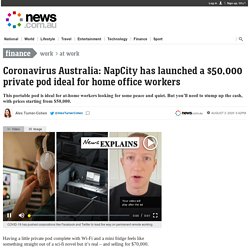
US tech company NapCity originally launched its never-before-seen ‘NapCabs’ for travellers in an airport wanting a place to wait and relax, but once COVID-19 hit, they had to think outside the square. Enter your own mobile office unit of 13x13sq m. The company has also suggested using their Nap Cabin for private medical waiting areas, conference rooms, mobile offices and even homeless shelters. RELATED: Follow our live NSW coronavirus updates here RELATED: Follow our live Victoria coronavirus updates here NapCity president Stephen Rosenfeld called the invention a “private space as a service”. With travel off the tables, and many international routes closed, Mr Rosenfeld is pitching his NapCabs as hotels, offices, wellness centres, and anything else that can fit in the space.
The inside and outside of the NapCab are customisable. Best tiny holiday houses to escape to around Australia. The tiny house movement has swept the globe – and while we’re all fascinated by the boom in these compact, minimalist homes, in reality, few of us are likely to make the dramatic downsize.
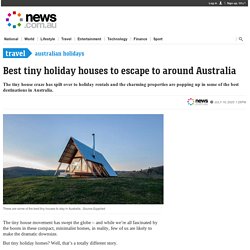
But tiny holiday homes? Well, that’s a totally different story. More and more tiny houses are popping up as holiday rentals around Australia, offering travellers all the charm and cosiness of a tiny house at a fraction of the cost of a comparable full-property stay. Double-storey houses are getting built in mere days with innovative tech.
PanelUp Prefab System build in Matraville New 3D construction technology has made it possible to build two-level houses in mere days, shaving months and up to $40,000 off the conventional construction process.

The prefabricated building system known as Panelup has radically sped up construction and means houses are at lockup stage in as little as seven days after the first slab is laid down. The technology was recently used for the construction of a two-level duplex in Matraville in Sydney’s east. This Dream Tiny House Is A Total Game Changer. Epic Modern Tiny House With Library Net Loft. Would you buy a home for US$5,000 on Amazon? Tiny homes, where to buy one – and how much it will really cost. Deciding on which type of tiny home to buy depends on a few factors.
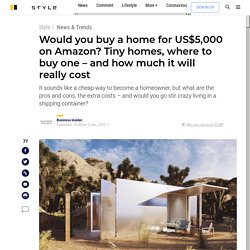
For someone drawn to tiny homes for their mobility and travel potential, a home on wheels, registered as an RV, is the way to go. It’s also important to consider where the tiny home will reside. This loft-style Japanese-inspired tiny home on wheels that can sleep 8 people for $69,800 — see inside the 'One XL'
Incredible BIG Modern Tiny House With Amazing Storage. Modular housing the building blocks of a smart home. "As a result, you can do a much better job of sealing your finished home against elements, plus you can do a better job of incorporation insulation – benefits which add up to make your home a lot more energy efficient.
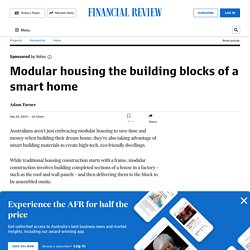
" Modular housing can also take advantage of the new generation of Phase Change Materials (PCMs), containing materials like wax which change from a solid to a liquid and back as the temperature fluctuates during the day. This process stores and releases heat, while retaining a near constant inside temperature more efficiently than traditional insulation materials.
Improved insulation, combined with other passive heating and cooling techniques, help curb energy bills and reduce a home's carbon footprint. Other environmental benefits of modular housing include the use of recycled materials and sturdy "mass timber" made from laminating together hardwood offcuts. Shipping container home is genius use of industrial materials - 9Homes. Peruvian architecture studio TRS Studio repurposes shipping containers as affordable homes. What do you get if you slam two shipping containers together?
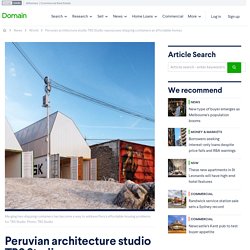
For Peruvian firm TRS Studio, the answer is a house. But before you write this off as hipster nonsense, there’s actually an important problem this design attempts to address. Shipping container hotel 'Contained' takes over Victoria's premiere wine regions - 9Travel. What is tiny-house living really like and how can it be made better? Opinion Updated about 5 hours agoMon 28 Jan 2019, 6:31am.
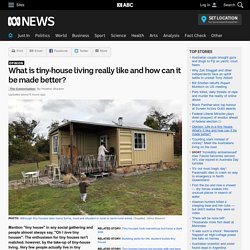
5 Luxury Tiny Homes That Are Cheaper Than a Fixer Upper. They say good things come in small packages—and fans of the tiny house movement seem to agree.
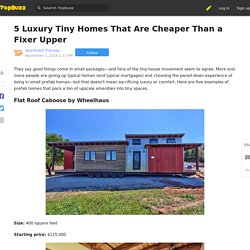
Residential Walls & Acoustic Fencing. No nails, no glue: Sydney architect creates ‘IMBY’ prefab cabin kit for extra space. Running out of space in your home?
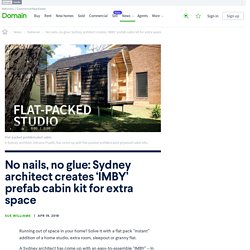
Solve it with a flat pack “instant” addition of a home studio, extra room, sleepout or granny flat. A Sydney architect has come up with an easy-to-assemble “IMBY” – In My Back Yard – a prefabricated plywood cabin kit that is delivered flat-packed and ready to put together by owners or occupants. “And you don’t even need an IKEA Allen key,” says its inventor Adriano Pupilli, who’s been trialling one at his own home on the south coast of NSW to provide an extra guest bedroom and home studio beside his small two-bedroom cottage. “It’s designed for easy DIY assembly with no real specific tools needed.
Adriano Pupilli, his wife Fiona, and their baby show the advantages of add-on living. 3D-printed home: Are these the answer to a mortgage free life. AN AMERICAN start-up thinks it has the perfect answer to your housing woes and it could soon be the key to a mortgage free life.
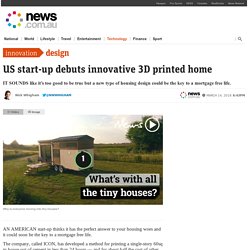
The company, called ICON, has developed a method for printing a single-story 60sq m house out of cement in less than 24 hours — and for about half the cost of other, similar methods. Using a proprietary printer, ICON can print an entire home for about $12,000 and says it plans to bring costs down to about $5500 per house. The model, which the company showed off at tech and music fair South by Southwest this week, boasts a living room, bedroom, bathroom, and a curved porch. According to its website, the company wants to leverage the power of robotics and cutting-edge materials to “make major advancements in affordability, building performance and sustainability.” Luxury shipping containers less than $50K that put your apartment to shame. We love a good shipping container home: it blends our tiny homes fascination with sustainability and repurposing. And we especially love when a cost-effective shipping container looks better than your regular home.
Las Vegas-based company Alternative Living Spaces is using premium materials to create homes from $47,000 that put your $400 per week rental to shame. Shipping containers make use of the thousands of surplus containers that sit on docks around the world. They're durable and an eco-friendly alternative compact space. Image: Alternative Living Spaces. Pop-up houses from Ten Fold Engineering assemble themselves in eight minutes. Some buildings are so advanced these days that they can build themselves, all you need to do is press a button. Eight minutes later, a new pop-up house from Ten Fold Engineering is completed and ready to be moved into. The Britain-based company recently unveiled its first prototype for the pop-up house after teasing with graphic renderings earlier this year.
Just press a button, and voila. Why the German concept of Passivhaus is the future of sustainable housing. Author: Gabrielle Chariton Passivhaus is a German approach to home design that uses a combination of high-performance glazing, insulation and an airtight building envelope to regulate a home’s internal temperature without relying on artificial heating or cooling. It’s a whole new way of looking at how we live, and it offers huge environmental credentials and dramatically reduced power costs – no matter where you live. The Passivhaus methodology is underpinned by five key components relating to how the home is designed and constructed. The ‘invisible’ mirror cabin that can be assembled in just eight hours. Whether you want a cabin, an Airbnb retreat or extra accommodation for the family, this little beauty ticks a lot of boxes.
Designed by Brick & Wonder for OOD in Estonia, the prefabricated mirror cabin can be assembled in just eight hours. The framing is steel and it’s clad on three sides with full-height Mirastar insulated glazing units, while the rear wall is clad in timber that supports various functions inside. Mirrored on three sides, this tiny house blends into the landscape so at times it is literally invisible. Photo: Anton Toomere Natural timber also features on the interior, which is well insulated with 200mm-thick mineral wool.
But it is the mirrored exterior that really attracts attention, reflecting the landscape back, so at times the cabin is essentially invisible. What’s not to love? – stuff.co.nz. Cairo ‘cargotecture’ company transforms shipping containers into homes. An Egyptian design duo has begun re-purposing old steel shipping containers, transforming them into living spaces, shops and restaurants in an effort to introduce residents of overcrowded Cairo to cheaper and more versatile properties. Qubix, a year-old company founded by Youssef Farag and Karim Rafla, delivered its first order in August after months spent testing different materials, techniques and insulation methods on a container in their back yard.
“Many people think that you’re going to be in a metal box, and that you’ll sit there and suffocate … Egypt is hot enough! But no, that’s not true,” Farag told Reuters. The containers, he said, are fitted with insulation designed to keep the temperature inside at a balmy 25 degrees Celsius. The ‘Plug-in House’ costs $13,000 and takes one tool to build. Takt pod is a reminder that small is beautiful. Build a granny flat for less than $10k. Muji unveils three micro homes for weekend getaways. Muji, the Japanese retail company renowned for its minimalist style, has taken simplistic design to a new level with the creation of three tiny homes designed for weekend getaways. The cult homewares company revealed three basic hut prototypes at Tokyo’s annual Design Touch event this month.
Muji collaborated with three designers – Naoto Fukasawa, Jasper Morrison and Konstantin Grcic – to create three huts made from three vastly different materials. Shipping Container House in Brisbane. You can now buy a whole house from Muji for $215,000. Japanese design giant Muji has moved from flogging homewares to selling homes. 3D-printed house built in just three hours in China's Xi'an. FeaturesReal Estate News. This excellent shipping container home was built for less than $27,000. Inside the converted shipping container. This excellent shipping container home was built for less than $27,000. Smarthouse_amh_brochure. Construction systems. The combinations of materials used to build the main elements of our homes — roof, walls and floor — are referred to as construction systems.
15 fabulous prefabricated homes. KLIK Australia - MODULAR BUILDING SYSTEM. ABCB - CodeMark Certified Products. Why Monarch. MiiHome Now deliver first instant relocatable homes. PROJECT BUILDER vs CUSTOM BUILDER. Monarch_Capability_Brochure(1).pdf. Active Building Systems. Distributed Energy Storage System (DESS) - Solar AustraliaSolar Australia. Six prefab homes shaping the future of construction as building revolution takes off. 15 fabulous prefabricated homes. 5 bedroom 3 bathroom Executive style kit homes. DIY Granny Flat kits from Nova Design Group (NSW & QLD) Construction systems. How Many Solar Panels Do I Need To Power My Home? Caravan parks and manufactured homes fact sheet. Caravan parks and manufactured homes fact sheet.